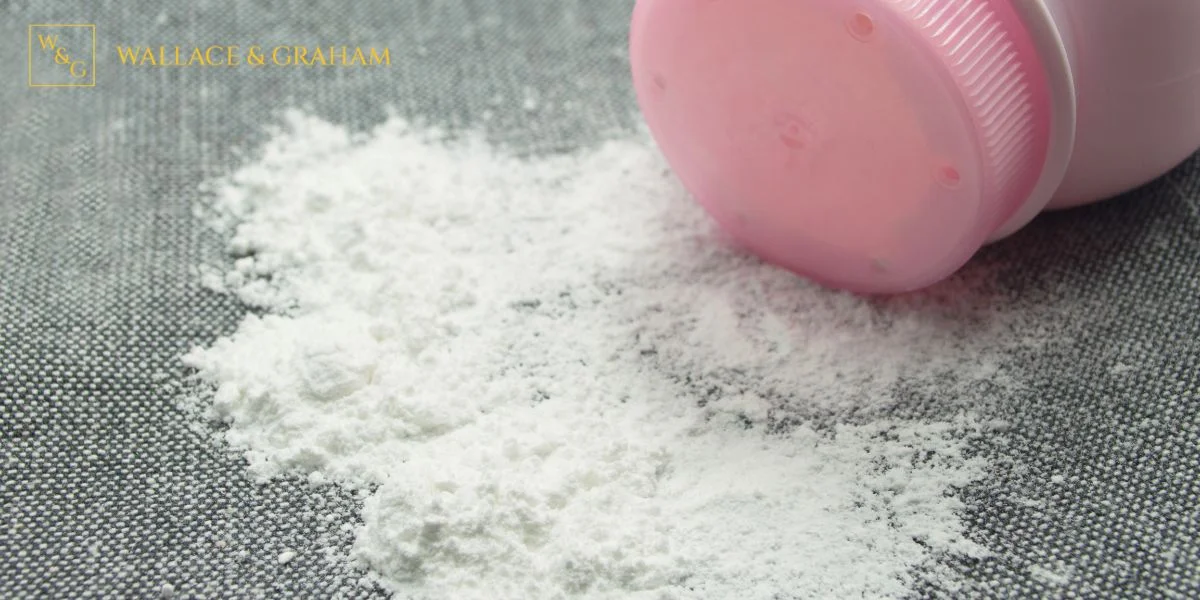South Carolina Talcum Powder Mesothelioma Lawyer
South Carolina Talcum Powder Mesothelioma Attorney
The mineral known as talc can come in contact with many individuals, including those who mine and process it as employees and those who use it in products as consumers. Asbestos can be found in naturally occurring talc, and exposure to this material can then result in significant health hazards. If you or a loved one has been diagnosed with mesothelioma after talcum powder or talc exposure, you need to speak with a qualified South Carolina talcum powder mesothelioma lawyer.
Both employees and consumers can be exposed to asbestos fibers from breathing in talc powder and dust from mined talc. These fibers can cause lung damage, respiratory illness, lung cancer, and mesothelioma. Severe damage is much more likely after lengthy exposure, such as when talcum powder is used in a daily routine or when employees mine talc for several years or even decades.
Companies that sell and manufacture talcum powder and other products that contain talc have been aware of these health risks to employees and consumers. Despite this, most companies have failed to take safety precautions to prevent asbestos exposure or properly warn their employees and customers. Many individuals have suffered significant illness because of that failure. This represents negligence, and sometimes gross negligence, on the part of these manufacturers, and they should be held accountable.
If you have suffered a developmental illness after using or working with talc products containing asbestos, you may be able to file a personal injury or workers’ compensation claim. This claim can recover medical bills for the illness, some income you lost during recovery, and other financial damages.

Wallace & Graham, P.A.: Asbestos Exposure Attorneys in South Carolina
When you suffer an illness because of talc and asbestos exposure, you can hold any negligent parties liable. When manufacturers release an unreasonably dangerous product, they can be held strictly liable for damages. Employees do not have to determine fault to file a workers’ compensation claim, but they may be able to file a personal injury claim if their employer was grossly negligent or intentionally caused the injury.
The type of claim you file will entirely rely on your unique situation. It’s crucial that you find an experienced attorney who understands the numerous types of talc exposure claims. At Wallace & Graham, P.A., our attorneys have more than 40 years of collective experience in mesothelioma and other asbestos- and talc-related claims. We bring skill, knowledge, and resources to every client’s case, fighting against manufacturers, employers, corporations, and property owners who fail to take proper care of individual safety.
Our goal is to protect your rights and financial interests. Our firm can stand up for you against the parties who failed to look out for your well-being. We can review your case, determine the cause of your illness, and build an effective claim.
What Illnesses Are Linked to Talc and Talcum Powder?
Talc and talcum powder can be contaminated by asbestos. Asbestos is linked to an increased risk of certain diseases, particularly when it is inhaled or ingested. Because mined talc releases dust into the air and talcum powder is dust, it is very often inhaled. This can include inhalation of asbestos fibers in the talc. If an individual inhales these fibers often for a long period of time, they are at an increased risk of:
- Respiratory Illnesses: These include asbestosis, diffuse pleural thickening, pleural effusion, and pleural plaques. These occur because the asbestos fibers build up in the lungs, causing lung tissue irritation and, eventually, scarring. It can make it harder for an affected individual to breathe and reduce lung capacity. These illnesses also increase the risk of cancers.
- Lung Cancer: Breathing in or ingesting asbestos fibers increases your risk of lung cancer. This risk is much higher for employees who mine, transport, and process raw talc. Lung cancer tumors can block air passages to the lungs.
- Mesothelioma: Asbestos inhalation and ingestion also increase the risk of mesothelioma. It is also the main cause of mesothelioma. This type of cancer forms in the tissues of specific organs, including the lungs, heart, stomach, and other organs in the chest and abdominal cavities. It is a very serious diagnosis with a low survival rate once it’s diagnosed, and it is difficult to catch early. Mesothelioma is particularly hard to navigate for asbestos claims, as it can take 30 years and as many as 60 years to develop after the first exposure.
Asbestos has a more tentative link with certain other types of cancers. If you are unsure whether you have a valid claim, be sure to discuss your illness and potential exposure with an attorney who understands talc and talcum powder claims.
Who Is at a Higher Risk of Asbestos Exposure?
Asbestos exposure occurs in many ways, and someone is at a higher risk of developing illnesses if they suffer low-level exposure for an extended period or high-level exposure for a short period of time. Some of the causes include:
- Regular use of talc-based cosmetics, including baby powder and body powder, and powdered makeup, like eyeshadow and blush. Manufacturers and distributors are liable for failing to sell safe products.
- Living in a building or home that contains asbestos-based materials, particularly when those materials are broken and fibers are released into the air. Landlords or property owners can be held liable for failing to warn about these hazards.
- Living or working in military buildings and handling military equipment made prior to the 1970s.
- Living with an employee who works in mining or transporting raw talc or is in any at-risk industry. Employees can carry fibers on their clothes and skin, exposing the people they live with to asbestos.
The most common reason why individuals are exposed to asbestos is because of their employment. Many industries have handled asbestos products in the past, and many of those products have not been discontinued. Employees are at a higher risk of frequent or significant exposure in some of the following industries:
- Talc miners, processors, and transporters. These people work directly in the extraction and transport of the material, giving them very high levels of exposure.
- Construction workers, especially those who work in or demolish old buildings. Asbestos can be found in insulation, ceiling and floor tiling, drywall, plumbing, roofing, paints, coatings, and adhesives. It is also used to strengthen cement and plastics, for fireproofing, and for sound absorption.
- Shipbuilding and shipyard workers, especially employees working on the repair and maintenance of older ships. Asbestos has been used for insulation on boilers, steam pipes, and water pipes.
- Steelworkers. Asbestos can be used in heat shielding.
- Automotive industry employees. The automotive industry has used asbestos for clutch pads and brake shoes.
- Textile industry workers. Asbestos was once used to weave heat-resistant garments.
- Power plant employees. Employees who have worked with products that use asbestos insulation are at a higher risk of developing asbestos-related conditions.
Talcum Powder Lawsuit FAQs
Q: What Is the Average Settlement for a Talcum Powder Case?
A: The average settlement for a talcum powder claim depends on many factors, and it can range from several thousand to several million dollars. Some of the factors that influence your settlement amount include:
- The severity of your illness and injury
- The exact financial and nonfinancial damages you suffered that are compensable
- Your attorney’s negotiation and litigation skill
- Whether the at-fault party acted with willful, wanton, or reckless disregard, resulting in punitive damages
- Your income and whether you are able to return to work
- Whether the case is settled in negotiation or goes to court
Q: How Do I Join a Talcum Powder Claim?
A: To join a talcum powder class action claim, you must first qualify for a talcum powder claim. This means that both of these things must be true:
- You suffered asbestos exposure due to use or work with talc or talc-contaminated products.
- You were diagnosed with an illness or cancer that is connected with asbestos.
If you meet these qualifications, you can contact a skilled attorney to either join a class action claim that they are already filing or begin a new claim. Your attorney can advise you on the right type of claim for your situation.
Q: What Is the Age Limit for the Talcum Powder Claim?
A: For most forms of talcum powder claims, there is no age limit. Claims may have a statute of limitations, but these rules are often more complex for asbestos exposure over time. This is because illnesses associated with exposure take years to decades to appear.
Although the South Carolina statute of limitations for personal injury claims is three years, asbestos claims often qualify under the rule of discovery. If you believe that you suffered an illness due to asbestos exposure, talk with an attorney to determine if you have the ability to file a claim.
Q: How Do You Prove That You Used Talcum Powder?
A: To prove that you used talcum powder in an asbestos exposure claim, you can use evidence such as:
- Medical documentation about your illness
- Medical reports, such as lung biopsies or other tissue samples
- Medical expert testimony
- Witness testimony
- Personal testimony of your use
You must also prove a link between the use of talcum powder and/or asbestos exposure and the illness that you developed. Some diseases, such as respiratory illnesses or lung cancer, are easier to connect. An attorney can help you gather this documentation and use their resources to prove these elements.
South Carolina Legal Support for Talc Asbestos Exposure
If you are unsure whether you have a valid claim for asbestos exposure through talc or talc products, contact Wallace & Graham, P.A. We can review your specific situation and determine if your respiratory illness or cancerous illness is the result of asbestos exposure. Then, we can calculate the value of your claim.







